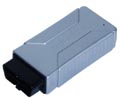- Variable Intake Control
- |
- Electrical Actuators
- |
- Repair Basics
- |
- Technical Info
- |
- Car Tech Info
- |
- MicroTronik
Variable Intake Control

Variable Intake Control 1

Variable Intake Control 2
1. Variable Intake System Outline
Variable intake system varies length of intake manifold in order to improve engine output over all engine operation range, and in particular increase engine output by approx. 10% at low-medium speed range.For frequent crowded downtown driving, engine shall provide high power at low-medium speed range. Highway driving and high speed running requires engine with high power at high speed range.
As to natural aspiration engine, if the engine is designed to generate high torque at low-medium speed, torque will decrease at high speed range. If on the contrary designed generated high torque at high speed range, torque will decrease at low-medium speed range. Therefore an engine that may generate high output over all operation range is desirable. Variable intake system corresponds to the various requirements of the driver, and enables engine to generate high power from low through high speed range.
The system controls air intake route depending on engine revolution and load condition in order to improve engine output over all engine operation range.
The basic principle of the Variable intake system is:
In low speed range the system closes intake control valve, and then the intake route will be extended to increase intake efficiency using initial property of the air, raising low speed torque. As engine rpm rises, more air will be taken into engine and then if extended intake route is still used, intake air resistance will increase, and resultantly decrease engine output. Therefore the system opens the valve at high rpm to take shorter air intake route. Then higher flow velocity enables sufficient intake of air.
As described above, the system increases low speed torque using extended intake route at low speed, and increase high speed torque using shorter intake route at high speed.
2. Variable Intake System Operation
As for variable intake system control, engine computer drives VIS valve motor based on engine rpm and engine load in order to control air intake route direction. At low speed or low load, the computer closes VIS valve to extend intake route longer than that of conventional engines, and at high speed or high load the computer opens VIS valve to shorten air intake route less than that of conventional engines, and then generate higher engine output over all speed range.The computer closes VIS valve at low speed or low load. When the valve closes, intake route will decreases as compared to conventional engines, increasing intake inertial force and consequently intake efficiency. Therefore intake efficiency will increase at low-medium speed range improving engine output and consequently engine output.
- Low speed and low load condition.
- Engine rpm: 4500rpm or less.
- Throttle valve opening: 70% or less.
Engine ECU opens VIS valve at high rpm and high load in order to make shorter intake route than conventional engines, and consequently reduce intake resistance. Then the reduced intake resistance will make intake efficiency relatively higher and result to increased engine output.
- High rpm and high load operation condition.
- Engine revolution: 4500rpm or less.
- Throttle valve opening: 70% or less.
Valve position sensor is installed on valve axis in order to detect accurate valve position when opening/closing valve. Valve position sensor is made of semiconductor, and operates with the same principle as HALL sensor. When engine is switched on, ECU will drive the servo motor to sufficiently close valve. Then valve will contact stopper. This status is initial setting. Thereafter, valve opening will be calculated depending on number of pulse signals. From full close status through full open status of valve, the sensor will receive total twelve pulse signals.
You can check the actuator actual value and status and activate it when it is possible by AutoHex automotive Diagnostic Scanner under the supported car brand and according to engine type.
BMW Key Programming F10, All keys Lost
Description
Variable intake system varies length of intake manifold in order to improve engine output over all engine operation range, and in particular increase engine output by approx. 10% at low-medium speed range.
For frequent crowded downtown driving, engine shall provide high power at low-medium speed range. Highway driving and high speed running requires engine with high power at high speed range.
Autohex II Reviews
AutoHex II
AutoHex II is your best choice to have full access to dealer functions like coding, adjusting and modules flashing/programming, Contact us for prices
AutoHex Forum


